The biggest entertainment stories
Get our big stories about Hollywood, film, television, music, arts, culture and more right in your inbox as soon as they publish.
You may occasionally receive promotional content from the Los Angeles Times.
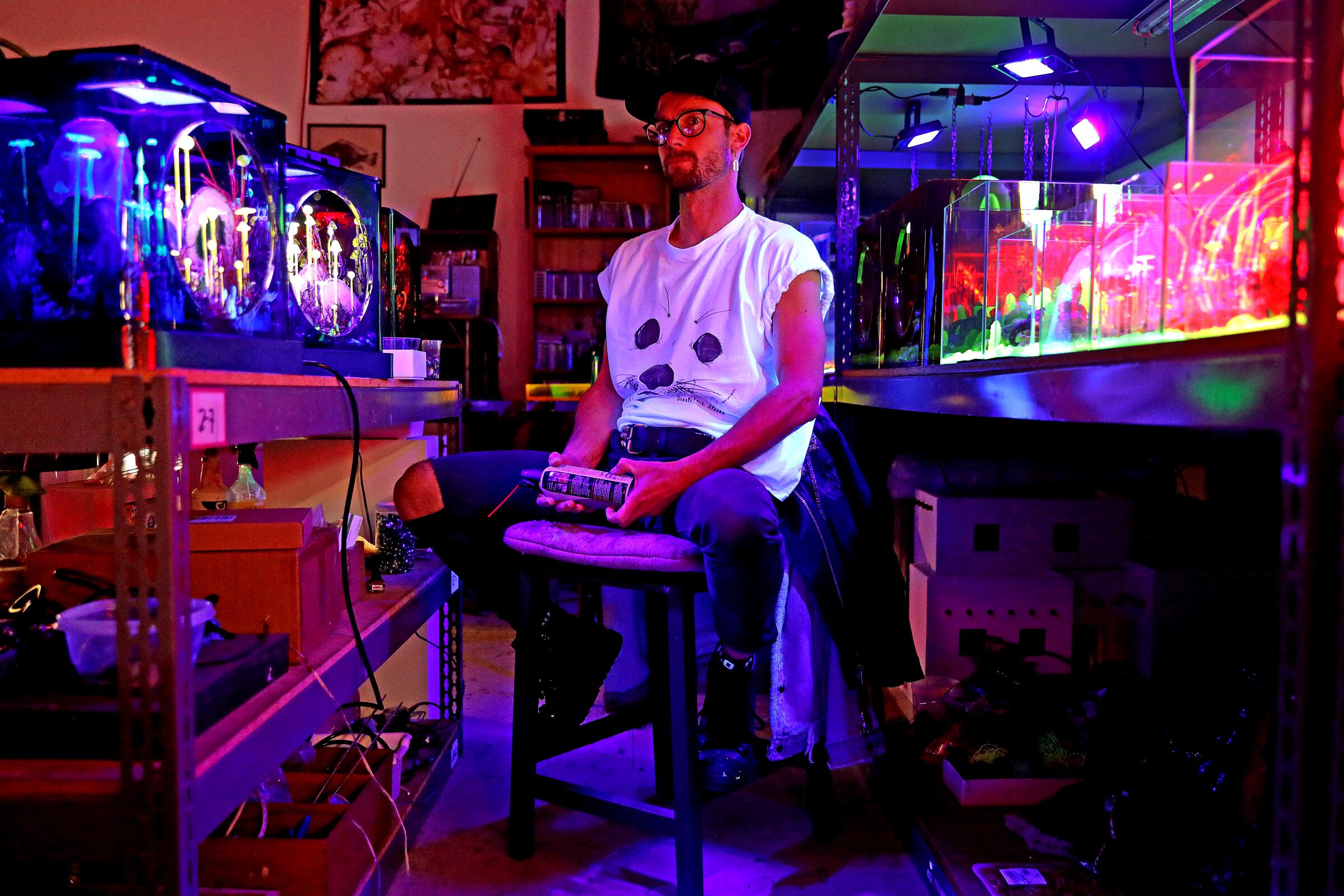
Within minutes of greeting me at his Baldwin Hills studio, artist Max Hooper Schneider summed himself up as “Mr. Paradox.”
The quip came in response to the table he’d laid out with both green juice and brownies, but it applies to pretty much everything he’s got cooking in the rooms beyond, works in progress and materials in various states of change and decay: a copper-plated orange, its desiccated remains rattling within the nubbed shell; a helicopter’s wrecked carcass suspended from the ceiling, dangling a spray of fluorescent tube god rays; a table spread with vintage neon signage fragments, like a scatter of found poetry; a hundred-dollar heap of McDonald’s French fries, five months old and counting.
“I think of the studio as a gut,” says Hooper Schneider, “and I’m like a digestive enzyme, circulating through it.”
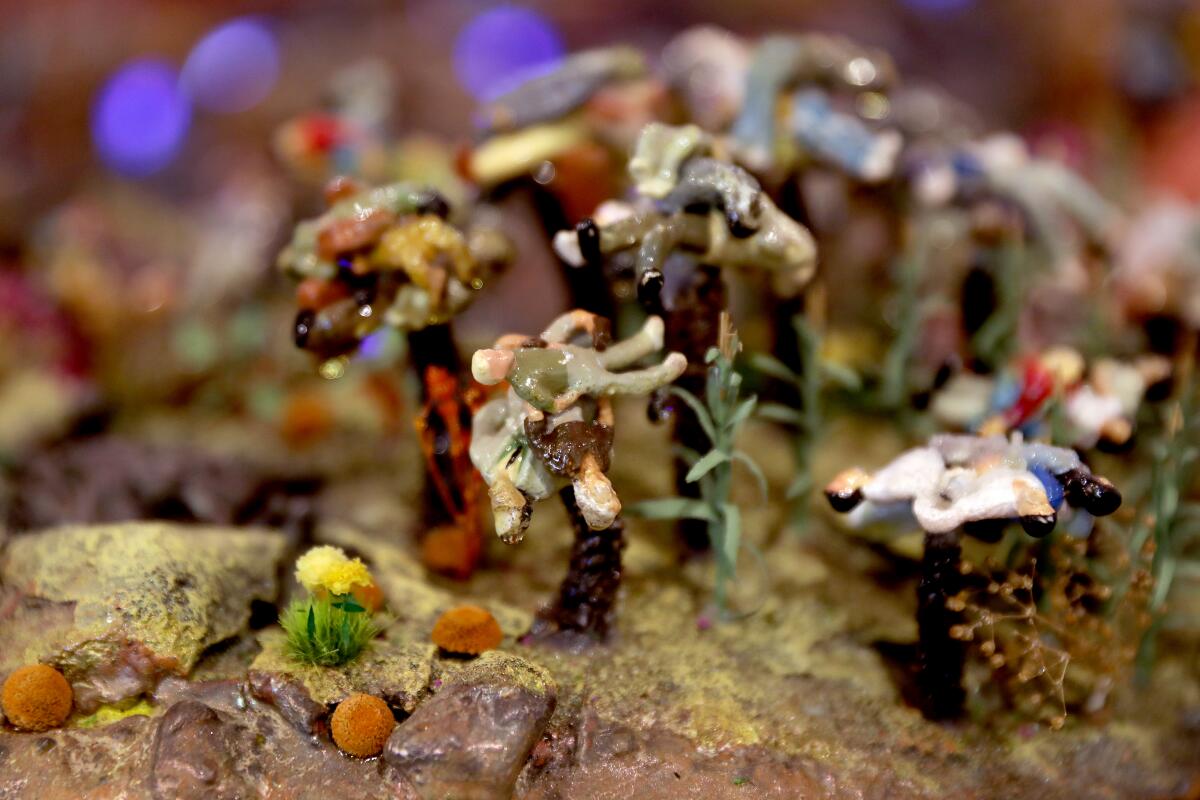
A dedicated runner who says the sport leaves him constantly hungry, Hooper Schneider reaches often for metabolic metaphors. The viewer’s encounter with his sculptures and installations, he has written, is a dynamic exchange between bodies “that is more akin to the mutually transformative process of eating than spectatorship.”
And not just ordinary eating, but a charged, complex kind of feasting. Sensory gluttony that yields dense nourishment for the mind.
“Falling Angels,” an extensive show of the L.A.-based artist’s recent experiments in biome devastation and regeneration, opens May 6 at François Ghebaly. The rooms of the downtown gallery will be darkened, and Hooper Schneider’s “disorienting vistas,” microcosmic scenarios that allude to macrocosmic phenomena of ecological, biological, anthropological and sociological distress, will be illuminated dramatically within.
“We do live in an age of crisis,” he says. “We’re living in the lethal effects of centuries of wanton destruction. My work looks at the crises, but it does seduce. It’s an intoxicant. Maximalism, horror, tragedy — I traffic in those, but only as tools to access things that are radically hopeful and joyous and exuberant.”
A group of tabletop vitrines in the show offers views of strange, sculpted, subaquatic splendor — luminous cast-glass mushrooms, sea anemones, bright ribbons of kelp. The works evolved in response to the artist’s experience of deep-sea diving in the Arctic, and as a rebuttal to Renaissance notions of the sublime, which center on nothingness and death.
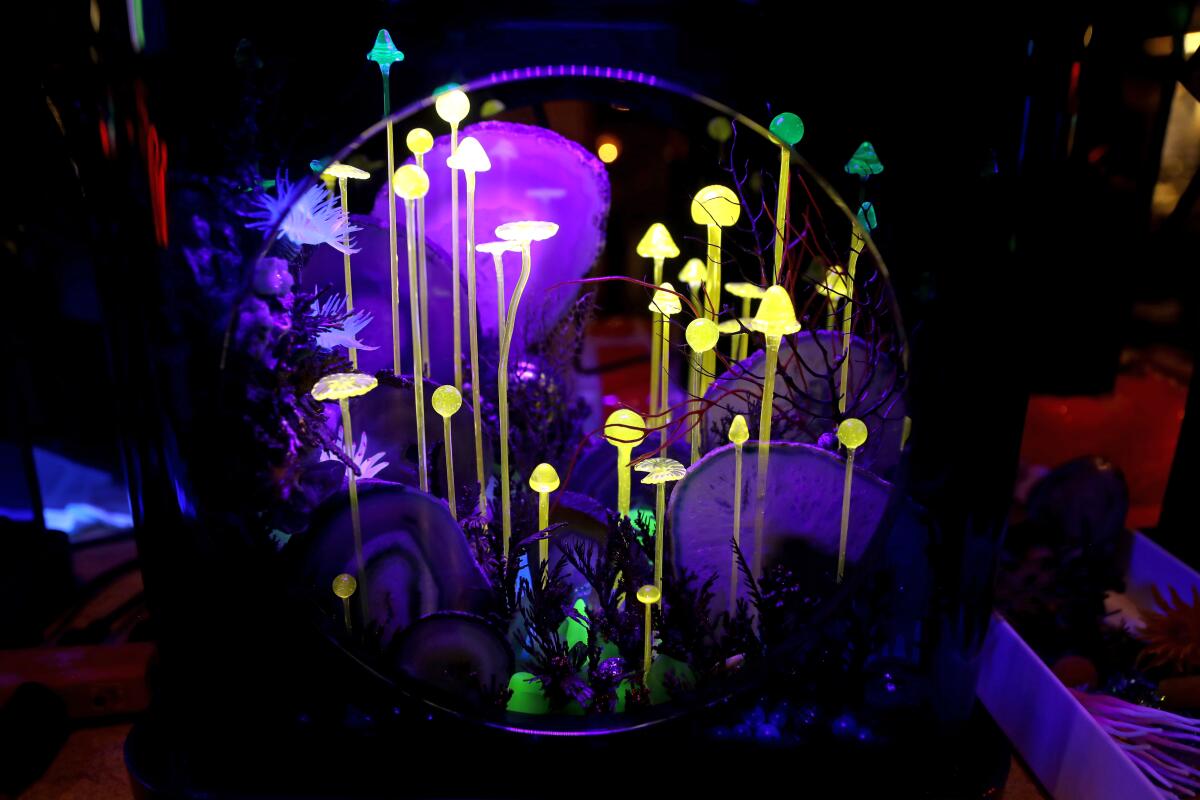
“Nothing is desolate,” he explains. “If you look hard enough, and think through the normal binaries of life, there’s a lushness to everything. Everything is a swarm of bodies teeming and festering and breaking down and regrowing.”
The vitrines themselves are distillations, and the cut-out portholes that provide a view inside are a further attempt to concentrate focus. Across the range of Hooper Schneider’s work, the miniaturization or abbreviation of a world (think dollhouses, model trains) coexists with an elaborate accumulation of stuff defining or filling that world. In an aquarium in his 2018 show at Jenny’s (a gallery that has since relocated to New York), for instance, tiny fish darted among their fake counterparts, swimming through trash/treasure heaps of costume jewelry.
Hooper Schneider revels in recasting the familiar as unfamiliar, absurd, extreme. In the case of the diving bell vitrines, “you get sucked in fast, and then suddenly, you get this mind-altering shift of scale. I don’t know what size I am. I don’t know what size I want to be anymore. And then there’s a chain reaction of seeing.”
Another of Hooper Schneider’s new “speculative habitats” draws on his childhood love of dioramas. In the large, tabletop environment, a derelict drive-in movie theater is set beneath a hillside of rhythmically laboring pumpjacks, a slope of exceedingly vibrant flowers, pits of ashen corpses, and palm trees with tiny human bodies in place of fronds. The large screen plays a film by the artist, intercut with old photographs collected by his maternal grandfather, “a flea market huckster.” Small screens within the audience of little junked cars flicker in conversation with “the parent screen.”
Max Hooper Schneider’s Hammer Museum installation is part “Raiders of the Lost Ark,” part Pirates of the Caribbean ride, part diorama of consumerism run amok.
The scene is suffused by nostalgia, at once disturbing and also, he claims, “incredibly playful.” Like the wider world it mines and mimics, this world, too, manages to thrive, even if we don’t recognize its newly emergent forms of life. Here and throughout his work, contradictions between vitality and decrepitude, nature and artifice, beauty and the grotesque don’t resolve in neutralizing harmony, but instead thrum on with generative friction.
Hooper Schneider is “a force,” says gallery owner François Ghebaly. “He’s one of the most innovative and exciting artists working in L.A. today” — and his self-proclaimed title of Mr. Paradox fits.
“This kind of work, dealing with a critique of capitalism, has paradoxes as a starting point — the natural world versus the man-made world, the recycling of society into something else, something unknown,” Ghebaly says. “He studied science to become an artist. That in itself is a challenge to the dominant narrative.”
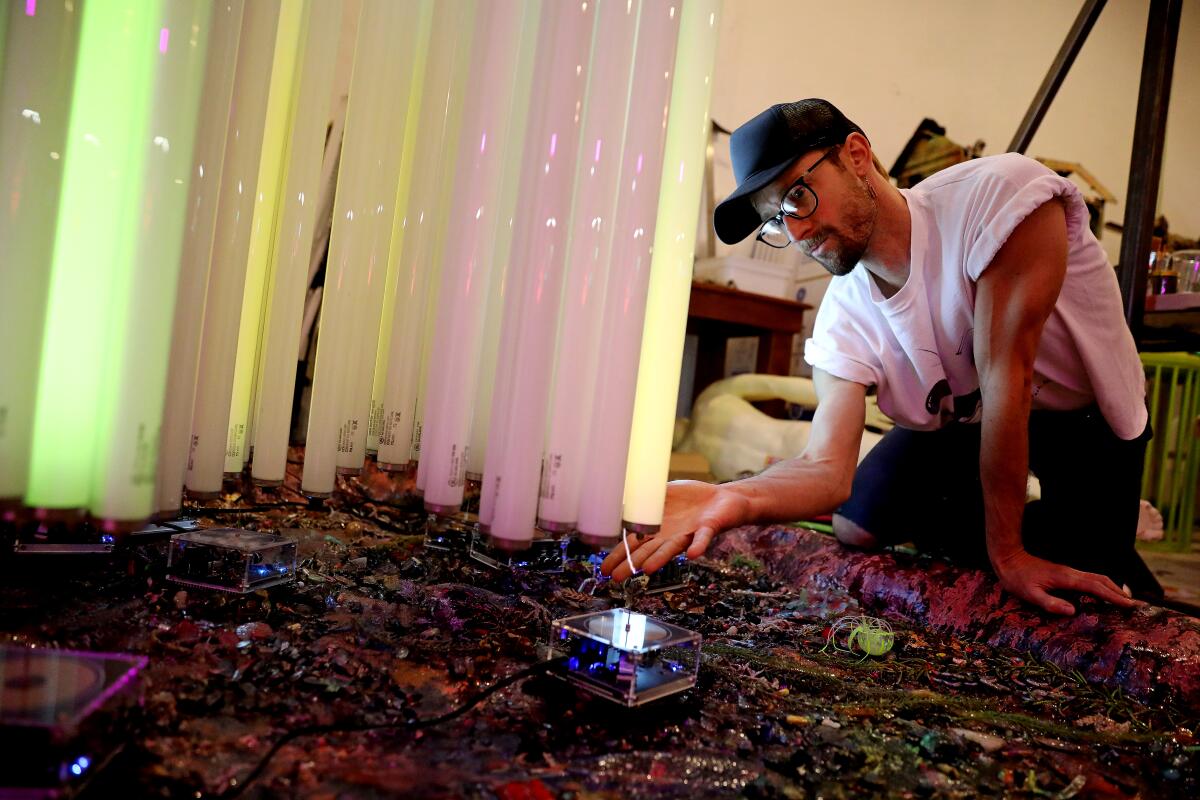
Hooper Schneider, 40, was born in L.A. and studied ikebana when young, around the same time he developed a passion for death metal. His late father was an equine veterinarian, and his mother, whom he reveres as “heroic, spirited, insanely brilliant,” is a retired philosopher and urban planning theoretician who taught at UCLA.
“I’m a cross section of the clinical and the metaphysical,” he says, “and my work is the tension between them. My work is only tension, it’s only in-betweens.”
He studied biology and urban planning as an undergraduate at NYU, and earned a master’s degree in landscape architecture at Harvard. The path through diverse disciplines gave him a skill set, he says, that facilitated his independence as a maker and a thinker. Essentially, he adds, “I did a ton of schooling to return to what I was doing as a kid, burning my Transformers and making new materials out of the quotidian bric-a-brac in front of me.”
Hooper Schneider has exhibited for roughly a decade, locally and internationally, and participated in the Istanbul Biennial, the Baltic Triennial in Vilnius, Lithuania, and twice in the Land Art Mongolia biennial. His works are in numerous institutional collections, including MOCA and the Hammer Museum. In 2019, for a Projects show at the Hammer, he turned the gallery into a stunning, disarming ocean-floor repository and living laboratory.
“I often refer to artists as alchemists and mad scientists, but he truly is,” says independent curator and Hammer adjunct Ali Subotnick, who organized that installation.
“He comes up with all of these weird ingredients and is constantly merging the classical sciences with being an artist. He’s confounding and full of so much energy. He really has created his own language and methodology.”
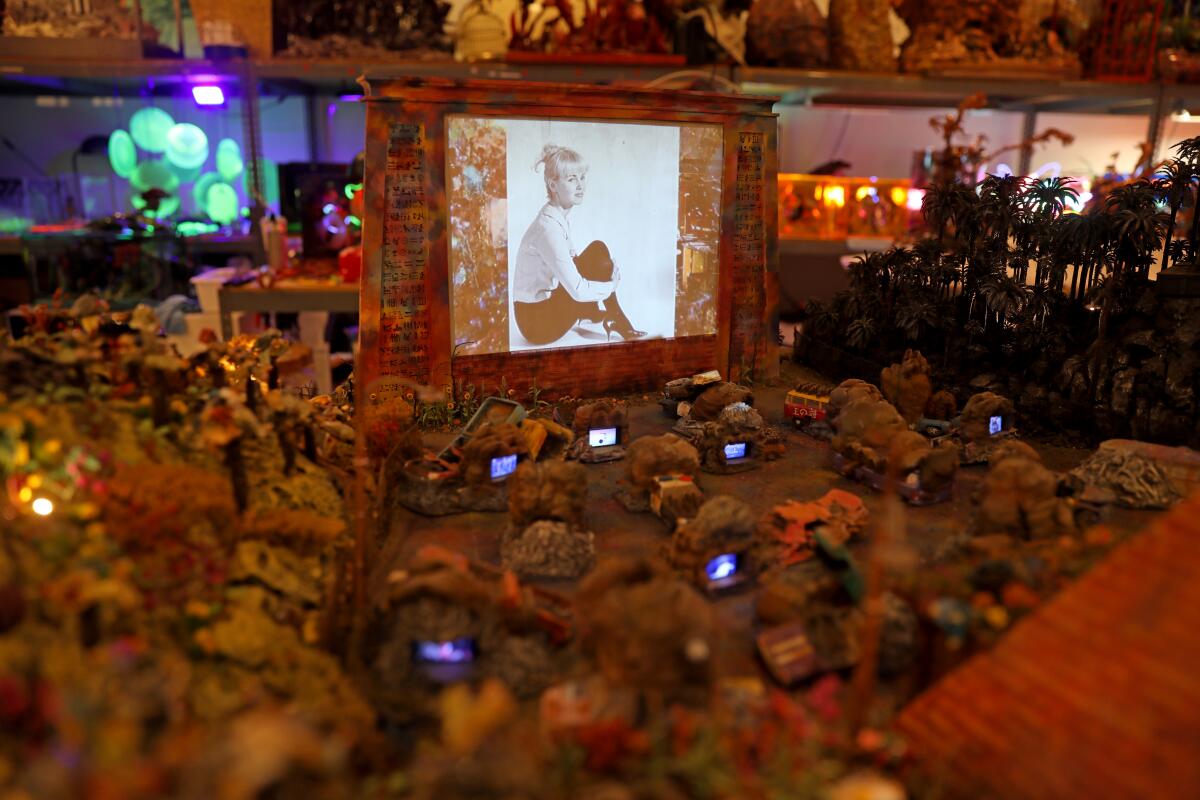
In a brief email before my visit to his studio in mid-April, Hooper Schneider described his work for the Ghebaly show simply as “feral.” When asked to elaborate, he followed up with a six-page “mission statement” articulating the ideas and sources behind the works, citing Marcuse, Spinoza, Mondrian and more. The visceral and the conceptual don’t just meet in Hooper Schneider’s work — they breed before our very eyes.
Hearing about the exhibition plan-cum-manifesto, Subotnick laughs with recognition.
“He uses words that go right over my head. Some of his text is impenetrable to me, but I love it and respect it. He’s full of contradictions. He’s smart and academic and knows all these big theories, but he’s also blasting heavy metal and wearing cutoff vests. Things don’t really match up, but that’s Max.”
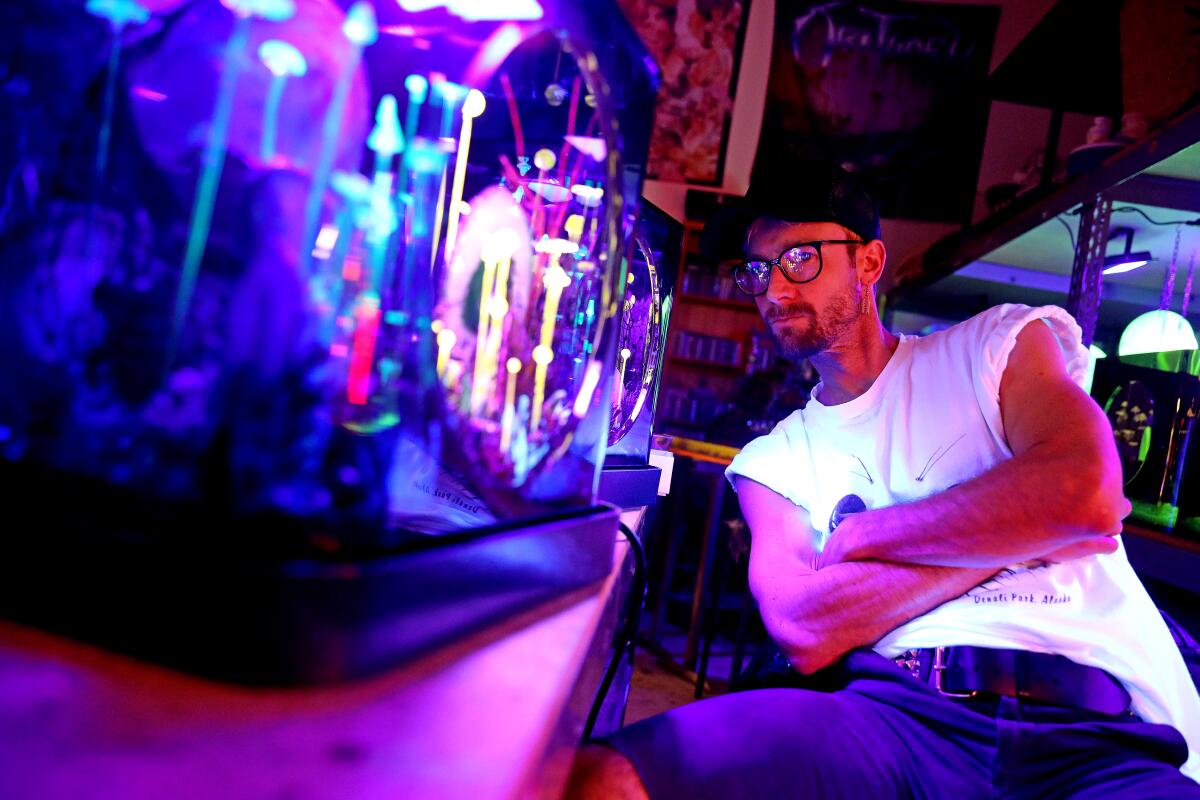
'Falling Angels'
Where: François Ghebaly, 2245 E. Washington Blvd., Los Angeles
When: Tuesdays-Saturdays, 11 a.m.-6 p.m. Through June 10.
Info: (323) 282-5187, ghebaly.com
The biggest entertainment stories
Get our big stories about Hollywood, film, television, music, arts, culture and more right in your inbox as soon as they publish.
You may occasionally receive promotional content from the Los Angeles Times.